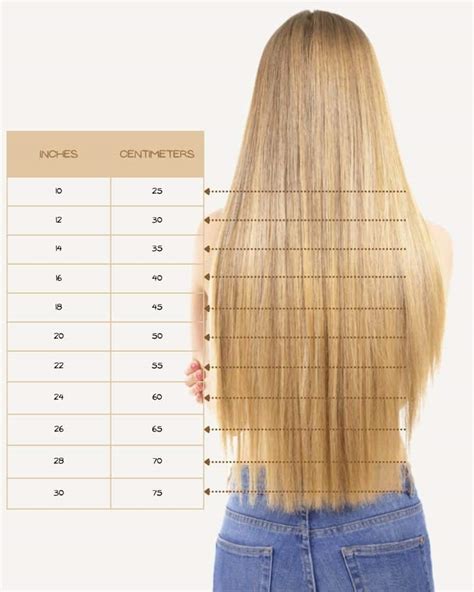Hair Length Measurement
Measuring hair length is essential for understanding its growth rate, determining the best haircare routine, and communicating with hair professionals. A hair inch chart provides a standardized method for accurately measuring and comparing hair length.

Inch-by-Inch Hair Measurement
12-Inch Hair Chart
- 12 inches
- 1 year of hair growth
- Just below the shoulders
- Popular length for short to medium hairstyles
14-Inch Hair Chart
- 14 inches
- 1.5 years of hair growth
- Shoulder length
- Versatile length suitable for various hairstyles
Intermediate Hair Lengths
16-Inch Hair Chart
- 16 inches
- 2 years of hair growth
- Mid-back length
- Ideal for medium to long hairstyles
18-Inch Hair Chart
- 18 inches
- 2.5 years of hair growth
- Just past mid-back
- Ideal for transitioning to long hairstyles
Long Hair Lengths
20-Inch Hair Chart
- 20 inches
- 3 years of hair growth
- Waist length
- One of the most popular hair lengths for women
22-Inch Hair Chart
- 22 inches
- 3.5 years of hair growth
- Extended waist length
- Suitable for those who want a longer, luxurious hairstyle
Extreme Hair Lengths
24-Inch Hair Chart
- 24 inches
- 4 years of hair growth
- Hip length
- Requires a high level of care and maintenance
26-Inch Hair Chart
- 26 inches
- 4.5 years of hair growth
- Extended hip length
- Considered a very long hair length
28-Inch Hair Chart
- 28 inches
- 5 years of hair growth
- Thigh length
- A hair length reserved for those with exceptional hair growth
Hair Inch Charts for Different Hair Types
The hair inch chart provides a general guide, but it’s important to consider your hair type when estimating hair length.
- Fine Hair: Fine hair tends to be more difficult to measure and may appear longer than it actually is.
- Medium Hair: Medium hair is the most versatile and can be easily styled into various lengths.
- Thick Hair: Thick hair tends to be shorter than it appears and may require more frequent trims.
Tips and Tricks for Measuring Hair Length
- Wet your hair to enhance its elasticity.
- Use a straight edge, such as a ruler or measuring tape.
- Measure from the scalp to the tip of the hair.
- Avoid measuring wet hair, as it can stretch and give an inaccurate reading.
- If your hair is damaged or uneven, take multiple measurements and average them.
FAQs
- How often should I measure my hair length? It’s recommended to measure your hair length every 6-8 weeks to track growth and adjust your hair care routine accordingly.
- Is hair growth affected by age or gender? Hair growth slows down with age, and men typically have a faster hair growth rate than women.
- How can I increase my hair growth rate? A healthy diet, regular exercise, and stress-reducing techniques can help promote hair growth.
- Can split ends affect hair length? Split ends can weaken the hair, making it more prone to breakage and reducing its overall length.
- What is the optimal hair length for hair health? The optimal hair length for hair health is between 12-16 inches, as longer hair can become damaged due to gravity.
- Can hair inch charts be used for hair extensions? Yes, hair inch charts can be used to determine the appropriate length for hair extensions, ensuring a natural blend with your own hair.
- What are the benefits of using a hair inch chart? Hair inch charts provide an accurate and consistent method for measuring and tracking hair growth, helping individuals make informed decisions about hair care and styling.
- Can hair inch charts help prevent hair damage? By monitoring hair length and adjusting hair care routines accordingly, hair inch charts can help prevent damage and promote hair health.
